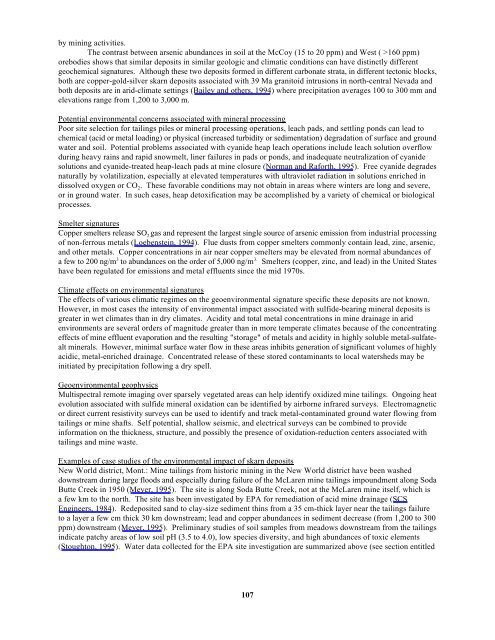CU, AU, AND ZN-PB SKARN DEPOSITS (MODELS 18b,c; Cox and ...
CU, AU, AND ZN-PB SKARN DEPOSITS (MODELS 18b,c; Cox and ...
CU, AU, AND ZN-PB SKARN DEPOSITS (MODELS 18b,c; Cox and ...
You also want an ePaper? Increase the reach of your titles
YUMPU automatically turns print PDFs into web optimized ePapers that Google loves.
y mining activities.<br />
The contrast between arsenic abundances in soil at the McCoy (15 to 20 ppm) <strong>and</strong> West ( >160 ppm)<br />
orebodies shows that similar deposits in similar geologic <strong>and</strong> climatic conditions can have distinctly different<br />
geochemical signatures. Although these two deposits formed in different carbonate strata, in different tectonic blocks,<br />
both are copper-gold-silver skarn deposits associated with 39 Ma granitoid intrusions in north-central Nevada <strong>and</strong><br />
both deposits are in arid-climate settings (Bailey <strong>and</strong> others, 1994) where precipitation averages 100 to 300 mm <strong>and</strong><br />
elevations range from 1,200 to 3,000 m.<br />
Potential environmental concerns associated with mineral processing<br />
Poor site selection for tailings piles or mineral processing operations, leach pads, <strong>and</strong> settling ponds can lead to<br />
chemical (acid or metal loading) or physical (increased turbidity or sedimentation) degradation of surface <strong>and</strong> ground<br />
water <strong>and</strong> soil. Potential problems associated with cyanide heap leach operations include leach solution overflow<br />
during heavy rains <strong>and</strong> rapid snowmelt, liner failures in pads or ponds, <strong>and</strong> inadequate neutralization of cyanide<br />
solutions <strong>and</strong> cyanide-treated heap-leach pads at mine closure (Norman <strong>and</strong> Raforth, 1995). Free cyanide degrades<br />
naturally by volatilization, especially at elevated temperatures with ultraviolet radiation in solutions enriched in<br />
dissolved oxygen or CO 2 . These favorable conditions may not obtain in areas where winters are long <strong>and</strong> severe,<br />
or in ground water. In such cases, heap detoxification may be accomplished by a variety of chemical or biological<br />
processes.<br />
Smelter signatures<br />
Copper smelters release SO 2 gas <strong>and</strong> represent the largest single source of arsenic emission from industrial processing<br />
of non-ferrous metals (Loebenstein, 1994). Flue dusts from copper smelters commonly contain lead, zinc, arsenic,<br />
<strong>and</strong> other metals. Copper concentrations in air near copper smelters may be elevated from normal abundances of<br />
3 3.<br />
a few to 200 ng/m to abundances on the order of 5,000 ng/m Smelters (copper, zinc, <strong>and</strong> lead) in the United States<br />
have been regulated for emissions <strong>and</strong> metal effluents since the mid 1970s.<br />
Climate effects on environmental signatures<br />
The effects of various climatic regimes on the geoenvironmental signature specific these deposits are not known.<br />
However, in most cases the intensity of environmental impact associated with sulfide-bearing mineral deposits is<br />
greater in wet climates than in dry climates. Acidity <strong>and</strong> total metal concentrations in mine drainage in arid<br />
environments are several orders of magnitude greater than in more temperate climates because of the concentrating<br />
effects of mine effluent evaporation <strong>and</strong> the resulting "storage" of metals <strong>and</strong> acidity in highly soluble metal-sulfatealt<br />
minerals. However, minimal surface water flow in these areas inhibits generation of significant volumes of highly<br />
acidic, metal-enriched drainage. Concentrated release of these stored contaminants to local watersheds may be<br />
initiated by precipitation following a dry spell.<br />
Geoenvironmental geophysics<br />
Multispectral remote imaging over sparsely vegetated areas can help identify oxidized mine tailings. Ongoing heat<br />
evolution associated with sulfide mineral oxidation can be identified by airborne infrared surveys. Electromagnetic<br />
or direct current resistivity surveys can be used to identify <strong>and</strong> track metal-contaminated ground water flowing from<br />
tailings or mine shafts. Self potential, shallow seismic, <strong>and</strong> electrical surveys can be combined to provide<br />
information on the thickness, structure, <strong>and</strong> possibly the presence of oxidation-reduction centers associated with<br />
tailings <strong>and</strong> mine waste.<br />
Examples of case studies of the environmental impact of skarn deposits<br />
New World district, Mont.: Mine tailings from historic mining in the New World district have been washed<br />
downstream during large floods <strong>and</strong> especially during failure of the McLaren mine tailings impoundment along Soda<br />
Butte Creek in 1950 (Meyer, 1995). The site is along Soda Butte Creek, not at the McLaren mine itself, which is<br />
a few km to the north. The site has been investigated by EPA for remediation of acid mine drainage (SCS<br />
Engineers, 1984). Redeposited s<strong>and</strong> to clay-size sediment thins from a 35 cm-thick layer near the tailings failure<br />
to a layer a few cm thick 30 km downstream; lead <strong>and</strong> copper abundances in sediment decrease (from 1,200 to 300<br />
ppm) downstream (Meyer, 1995). Preliminary studies of soil samples from meadows downstream from the tailings<br />
indicate patchy areas of low soil pH (3.5 to 4.0), low species diversity, <strong>and</strong> high abundances of toxic elements<br />
(Stoughton, 1995). Water data collected for the EPA site investigation are summarized above (see section entitled<br />
107

















